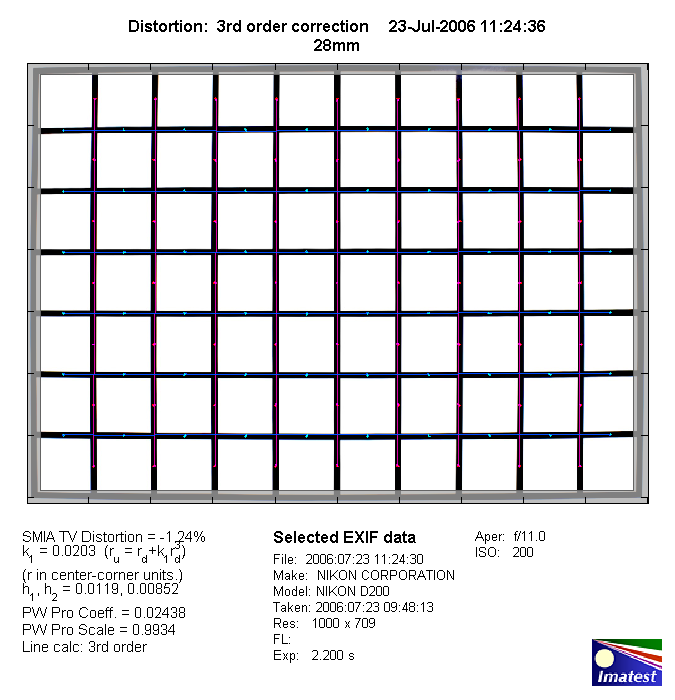|
Page 2 of 2

Distortion
The lens shows a moderate amount of barrel distortion on a DX camera.

The chart above has a real-world size of about 120x80cm.
Vignetting
On a DX camera the Nikkor shows slightly pronounced vignetting wide open. Stopped down vignetting is reduced to a level that is no longer an issue for most subjects.

MTF (resolution)
The lens shows very good resolution in the image center at the largest aperture and excellent values when stopped down.
The borders show good resolution wide open, which stays more or less on the same level even when stopped down.
The extreme corners are just fair wide open, but increase to good values by stopping down to f/5.6 or f/8.
Please note that the MTF results are not directly comparable across the different systems!
Below is a simplified summary of the formal findings. The chart shows line widths per picture height (LW/PH) which can be taken as a measure for sharpness.
If you want to know more about the MTF50 figures you may check out the corresponding Imatest Explanations

Chromatic Aberrations (CAs)
Chromatic aberrations (color shadows at harsh contrast transitions) are moderate at large apertures, but increase considerably by stopping down.
Note that CAs can be corrected in software or by the camera itself (most modern Nikon DSLRs remove CAs themselves if you shoot JPGs). However, with values that high, CAs will have an influence on perceived sharpness, even if the colour cast at contrast edges can be easily removed.

Bokeh
With its ability to focus rather close combined with the large aperture the lens is able to separate the main subject from the background (at least for larger subject-to-background distances). So, let's have a quick look at the bokeh quality.
Out of focus areas show some nervousness and double contures. Background highlights are somewhat distorted towards the image borders at f/2.8 and f/4 From f/5.6 onwards the aperture shape with its straight blades (not rounded) starts to become visible here. Quite strong outlining increases the overall unpleasant character of the lens' bokeh.

Sample Images
You can find some sample images taken with the Nikon D3x in our Nikon FX review of the lens.
VerdictThe Nikkor AF-D 28mm f/2.8 shows very good to excellent sharpness in the image center and good borders throughout the tested aperture range. The corners are soft wide open but increase to good values at medium apertures.
Distortion moderate and vignetting no issue, except wide open. CAs are very pronounced stopped down, but can be taken care of in post-processing.
The build quality is very good. Unfortunately the lens has no internal motor, which means it doesn't autofocus on Nikon's entry-level DX cameras.
Even though the lens is quite affordable, there are simply more attractive choices for DX shooters looking for a normal lens. Several dedicated DX lenses are available today (like the Sigma 30/1.4 DC, Nikon AF-S DX 35/1.8 or Tokina 35/2.8 Macro), which perform better than the AF-S 28/2.8 maybe not in all, but in many regards.
|